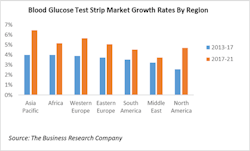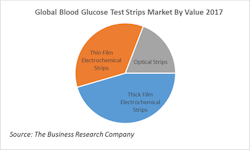Diabetes Epidemic Fuels Growth in Blood Glucose Test Strips
The global market for blood glucose test strips will be worth $12.93 billion in 2021, its highest ever level, according to a report from the Business Research Company. Global sales of anti-diabetic drugs will also reach a record $121.2 billion. The explanation in both cases is the same: the worldwide explosion in the number of people with diabetes, especially the Type 2 variety. Between 2015 and 2021, the number of people diagnosed with diabetes will jump from 415 million to 425 million—a figure that is expected to rise to 642 million by 2040. Between 2017 and 2021 the market for blood glucose test strips will also increase, going from 3.15% a year to 5% a year. Driving the market will be the growing rate of diabetes prevalence around the world caused by lifestyle factors.
Obesity, a major risk factor for diabetes, is increasing rapidly in areas of the world that were previously notable for malnutrition. For instance, obesity in the Asia-Pacific region has grown rapidly from 2012 to 2016, increasing 5.9% a year in India, 5.5% in China, and 4.5% in Japan. Increases in obesity in these populations are directly proportional to their rise in diabetes cases and indirectly to growth in the blood glucose test strip market. As a result, Asia Pacific has the fastest-growing demand for test strips, followed by Africa.
Blood glucose test strip sales will increase despite the rise of lower-priced generics that will affect the size of the test strip market by value. Generic test strips work with a variety of blood glucose meters and are much less expensive than their counterparts. Suppliers of meters have begun promoting or supplying strips to patients. For example, Pharma Tech Solutions, a California-based company, distributes Shasta GenStrip, a more affordable alternative that can be used with its One Touch and Ultra brand meters. Other generic strip brands in the market include Unistripii, GenUltimate iii, Equateiv, and Relion. The wider availability of these cheaper products will restrain the value of the test strips market by value.
Another restraint comes from the rise of substitutes. The introduction of new blood tests for blood glucose levels is a growing trend in the market. For instance, in July 2017, Abbott Laboratories launched FreeStyle Libre glucose monitors in New Zealand. These eliminate the need for routine finger pricks. In 2017, MIT’s Media Lab and Harvard Medical School collaborated on R&D focusing on diabetes tattoos with biosensors that check glucose levels in the body.
Many diabetes patients are afraid or unwilling to prick themselves with lancets each time for testing. The American Diabetes Association (ADA) recently recommended the use of the HbA1c test for diagnosing diabetes. Previously, HbA1c monitors were approved by the U.S.’ Federal Drug Administration only for long-term glucose control, but that is under review for extension to Type 2 monitoring. Diabetes Australia now also recommends HbA1c testing every three to six months for Type 2 diabetics. These alternative methods of diabetes testing will cut into the test strips market.
The biggest-selling test strips, worth about two-thirds of the global market, use glucose dehydrogenase sensors. Glucose dehydrogenase is an enzyme or protein catalyst that accelerates oxidation of glucose into gluconic acid. Glucose dehydrogenase is less susceptible than glucose oxidase to common interferences.
Glucose dehydrogenase-based strips are less expensive and more accurate and specific than the main alternative (glucose oxidase strips), as there is no cross-reactivity from other blood sugars such as maltose, galactose, or xylose. Not surprisingly, perhaps, the market for glucose dehydrogenase strips is much larger than that for glucose oxidase strips, both globally and in countries across the world. The market for glucose dehydrogenase strips is also growing over twice as fast as that for glucose oxidase strips. When the market is segmented by electrode materials used in thick and thin film strips and optical strips, the largest segment is for thick film strips, which are worth nearly half the global total.
Thick-film electrochemical test strips contain several layers including analytical, separating, and support layers. Each strip has working and reference printed electrodes coated with reagents and membranes. Thin-film electrochemical test strips consist of glucose enzyme electrodes on thin layers of enzyme glucose oxidase, and are entrapped over oxygen electrodes via semi-permeable dialysis membranes.



